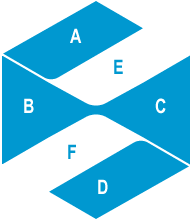- Home
- About METI
- Logo of the Ministry of Economy, trade and Industry (METI)
Logo of the Ministry of Economy, trade and Industry (METI)
What this logo symbolizes
METI’s logo symbolizes the following.

- Sections A and B together represent industry, and Sections C and D trade. A combination of these two pairs forms a tomoe pattern, a Japanese traditional heraldic design resembling a swirl. The design also looks like an ascending spiral to deliver an image of growth.
- B and C, positioned in the center of the logo, integrally symbolize stability and equilibrium, representing the balanced growth of industry and trade which allows dynamic rotation.
- B and C, drawn in perspective, occupy broad, deep dynamic space. Their width symbolizes quantitative expansion, while their condensed depth reflects qualitative expansion.
- The two units formed by A and B and by C and D respectively are organically linked at the center. This link represents the correlation between industry and trade, the key to the Japanese economy.
- E and F represent nature, including people’s lives and the natural environment.
- E penetrates between A and B, and F penetrates between C and D. The penetration, though narrow, reaches the outside, or natural world. This implies that both industry and trade incorporate the natural order into their structures, and that a link to nature must be ensured, however indefinite it may be.
- The entirety of the logo forms a regular hexagon, which symbolizes harmony. METI's activities constitute part of the unified administration of the government. Collaboration with other ministries and agencies is indispensable. Each side of the hexagon is designed to represent this close collaboration.
Designer of the logo
This logo was created by the Ministry of International Trade and Industry (the predecessor of METI) in 1975 to commemorate both its own 25th anniversary and the 50th anniversary of the Ministry of Commerce and Industry. It was designed by Mr. Yukio Ota, a pioneer in communication design in Japan who has created a variety of famous marks, such as the emergency exit mark, which was designated as an international standard by the International Organization for Standardization (ISO).

Designer Yukio Ota
Born in Aichi in 1939; graduated from Tama Art University and completed its Graduate Program; completed the program of the Accademia di Belle ARTI in Italy; assumed the office of Director of the Japan Society for Science of Signs, served as a professor at Tama Art University, and now serves as Director of the Sign Center (NPO) and representative of Yukio Ota Design Associates; has conducted R&D on the LoCoS language and has designed various public signs and logos, including pictograms such as the emergency exit mark and evacuation area mark.
Division in Charge
Public Relations Office, Minister's Secretariat